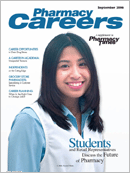Publication
Article
Pharmacy Careers
STUDENTS/RETAIL REPRESENTATIVES DISCUSS THE FUTURE OF PHARMACY
Author(s):
PHARMACY TIMES RECENTLYheld a student/retailer roundtable on theFuture of Pharmacy to discuss some ofthe key issues affecting pharmacy.
The impact of Medicare Part D wasa topic of huge interest among all panelists.Participants said that after theinitial struggles of the enrollment period,they see some benefits. They areproud of the way pharmacists servedtheir communities, and they are hopefulthat an increased focus on medicationtherapy management (MTM) canraise the profession's profile.
JT Leatherwood, director of collegerelations and professional recruitmentat Rite Aid, said he was impressed withthe level of assistance community pharmacistsgave to patients during theenrollment period. "The training thatwent into it was impressive, but thegreatest thing was that it was a timewhen pharmacists stepped up and didwhat was right. It was overwhelming," he said."Pharmacists as health care professionalsstepped up and did the rightthing and worked with the patients."
Pharmacists were proud of the jobthey were able to do in the face ofmany enrollment challenges. "I thinkthat the first month of 2006 we alllearned to be very adaptable veryquickly," said Scott A. Miller, directorof clinical education and medicationservices at Walgreens Health Services."Pharmacists, especially the peopleout in the trenches, they were definitelythe heroes of January 1, 2006."
Leatherwood and Miller agreed that,from the implementation standpoint,Medicare Part D posed challenges.Theysee the plan as a positive force, however,for the industry and for patients.
"There are a lot of people who traditionallywere not getting medicationsor would go without.What we're seeingnow is, even though there are a lot ofproblems getting people enrolled intothe proper plan and having themunderstand the plan they are in, theyare at least getting their medications," said Miller.
"It is a benefit that finally allowed usto break down those financial barriersfor low-income seniors, as well as otherswho just did not have the coverage totake care of their patient needs," saidPapatya Tankut, vice president of pharmacyprofessional services for CVSCorp."I think we are proud, as an industry,to have served our patients to be ableto get the medications they needed."
Tankut believes that Medicare PartD's effect on the industry is just beginning."Part D in itself is one single eventthat is forever going to change ourindustry," she said. She believes pharmacistswill be providing more supportto patients as they consider differentplans and as more enroll.
"I think it just becomes ingrained inwhat we do as professionals and healthcare providers to incorporate Part D. It isjust what we do now. It is our business,and we will incorporate it into the dailystruggles that we may have," she said.
The infamous "doughnut hole," when patients will actuallybegin to see how much they are paying for their medications, willbe another challenge for pharmacists.Walgreens'Miller said pharmacistsshould be preparing to educate patients by showing themhow much they saved and how their plan is working. "It isalways going to come back to the pharmacist, because they aregoing to be the ones front and center," said Walgreens'Miller.
Panelists credited Medicare Part D with turning the spotlighton MTM. They agreed that pharmacists need to find ways tomaximize the opportunity for the industry.
"We've been struggling and arguing for years that we need tobe paid for our services, for our cognitive abilities, and we havenever really made it anywhere until we got Medicare Part D.This is our opportunity," said Walgreens'Miller.
Students agree that MTM services are a boon for the industry.Thomas Gage, a student at University of Texas at AustinCollege of Pharmacy, said that since the curriculum haschanged to a more clinically-based, disease-oriented focus,more students are excited about providing these services. "I canhave more of an impact in the community setting," he said.
Corporate panelists agreed. Rite Aid's Leatherwood said thatpharmacists "miss the joy of the job when they are standingbehind a counter."
Tankut said CVS is looking at ways the chain can provideMTM services to its patients without disrupting work flow. "Anaverage pharmacist should be able to provide these services," she said. " Pharmacists are health information providers. Wecan change our destiny. We are a key part of the health careteam. Automation and technicians will allow us to get there."
Increasing the use of pharmacy technicians is a strategy allpanelists supported. Jenny Tuttle, a student at Drake University,advocates "using the technician to do everything that theycan legally." "We have to embrace services," she said. "We arenot just pill dispensers."
Most students said that they are comfortable with the level oftraining of techs they have encountered and say they feel comfortablerelinquishing dispensing duties to techs in order to take onexpanded patient care responsibilities.
Tankut advocates training techs to "allow them to shift the prescriptiondispensing, the systems functions, the production, andtechnical functions of our job away from the pharmacist so we canallow our pharmacists to do what it is they do best, which is patientcare. That is the ultimate goal."
Gage even advocates empowering technicians to get into thecommunity and educate patients. Howard Kramer, director ofpharmacy human resources at Kmart Pharmacy, also supports theexpanding role of technicians and continues, "I think that the timeis right to make better utilization of pharmacy technicians." Heemphasized that states are steadily increasing pharmacist-to-techratios and allowing them to take on additional tasks, suchas taking a prescription from a physician's office over the phone.Lastly, Kramer added, "I believe the pharmacist should be theone involved in MTM, but the use of technicians will free up thetime to do that."
Ms. Sax is a freelance writer based inChevy Chase, Md.







